LAWS20058 Australian Commercial Law Term 1, 2018: Assignment Solution
VerifiedAdded on 2021/05/31
|8
|2417
|22
Homework Assignment
AI Summary
This document is a comprehensive solution to an Australian Commercial Law assignment (LAWS20058). The assignment addresses key legal concepts including Hart's three-part legal system, misrepresentation, and breach of contract. Part A analyzes the UK legal system through the lens of Hart's framework, comparing it with the Australian system. Part B delves into a case study involving a business sale, offering legal advice to Barry on whether a contract is voidable due to misrepresentation by Angelo. The solution considers relevant legislation, such as s. 18(1) of the CCL, and case law, including Smith v Hughes and Redgrave v Hurd. Furthermore, the assignment determines whether representations made during the pre-contractual phase constitute terms of the contract, offering advice to Barry regarding a potential breach of contract. It examines factors such as parole evidence rule and the expertise of parties, referencing cases like Oscar Chess Ltd v Williams and Bannerman v White. The assignment concludes with a legal analysis and recommendations based on the provided facts and legal principles.
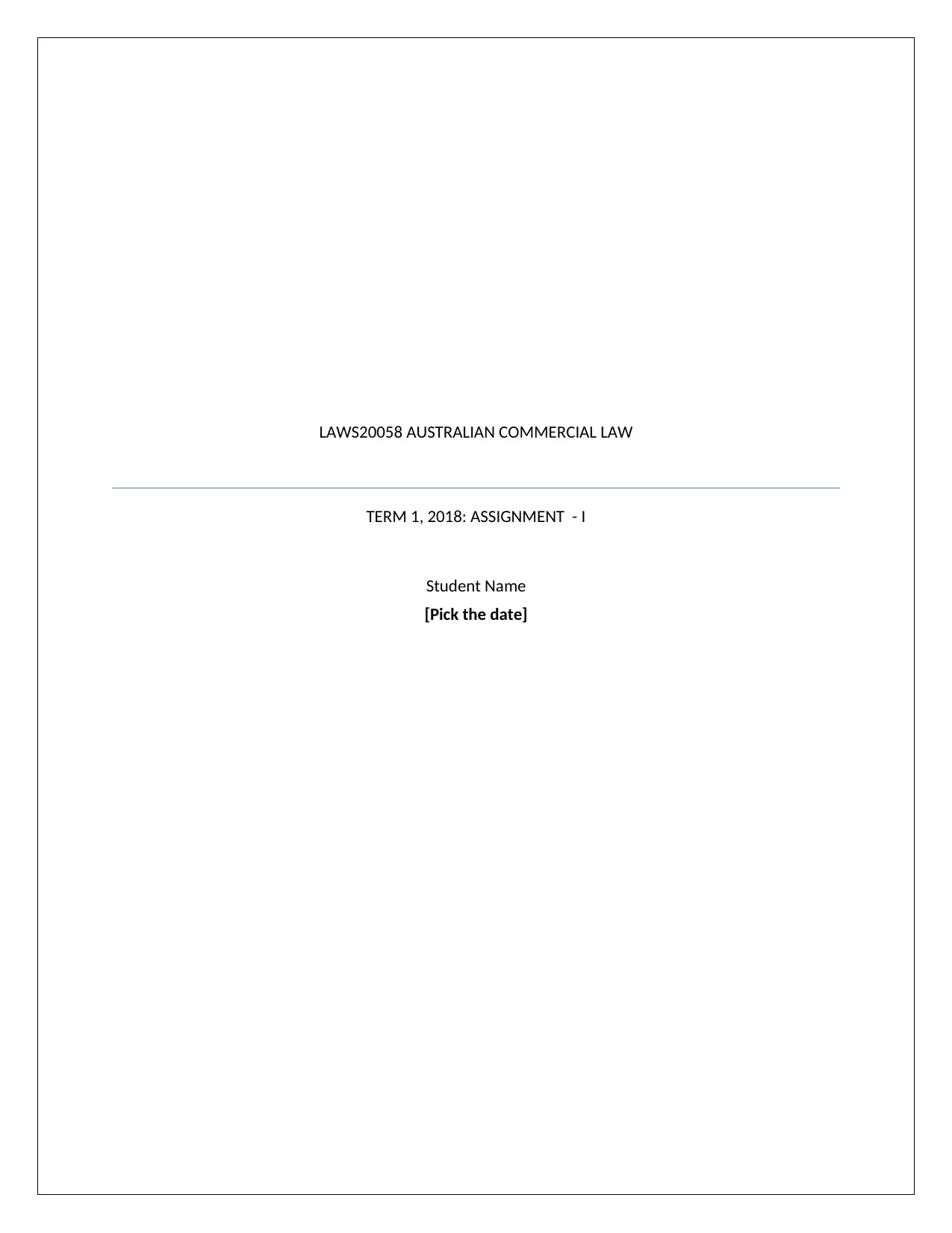
LAWS20058 AUSTRALIAN COMMERCIAL LAW
TERM 1, 2018: ASSIGNMENT - I
Student Name
[Pick the date]
TERM 1, 2018: ASSIGNMENT - I
Student Name
[Pick the date]
Paraphrase This Document
Need a fresh take? Get an instant paraphrase of this document with our AI Paraphraser
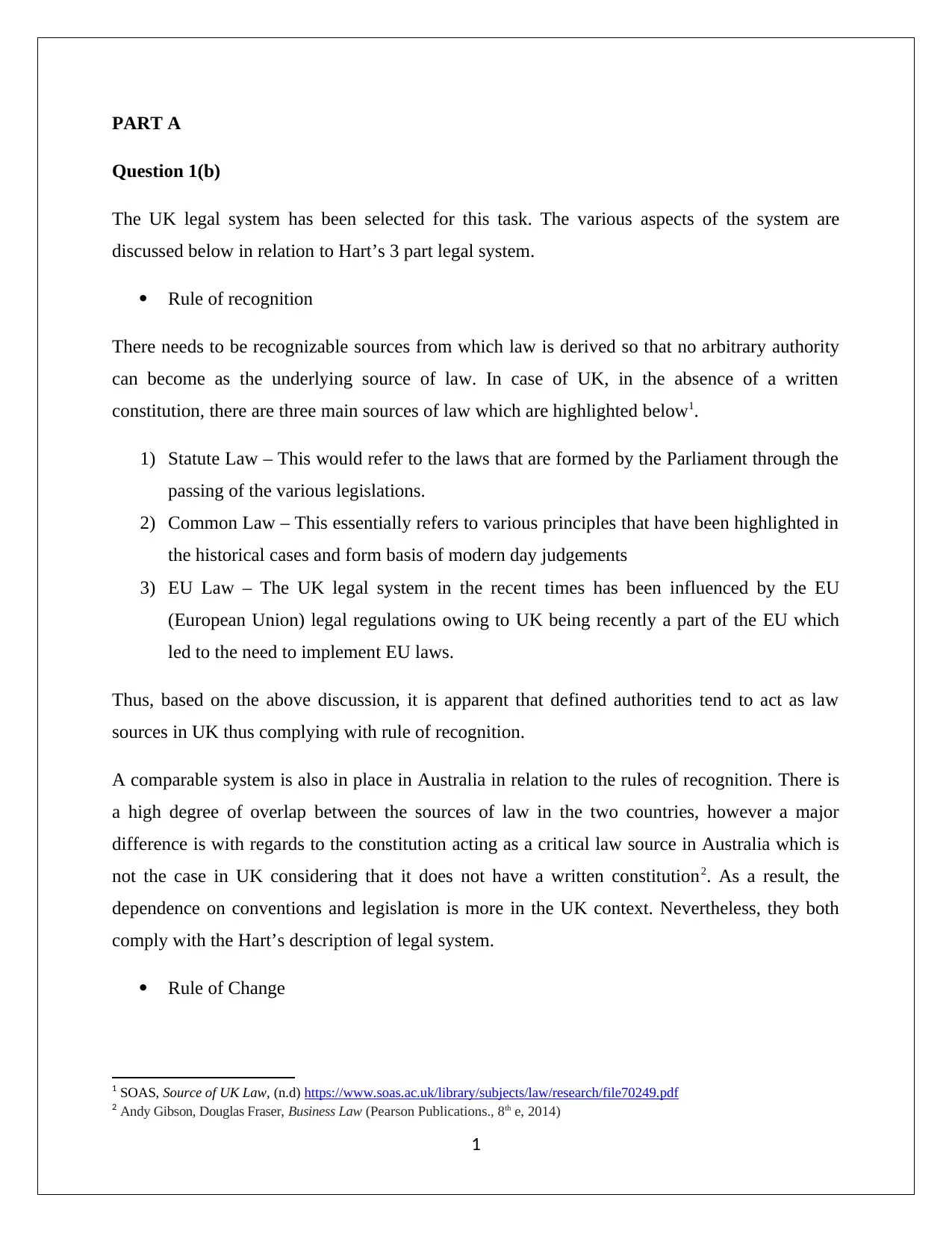
PART A
Question 1(b)
The UK legal system has been selected for this task. The various aspects of the system are
discussed below in relation to Hart’s 3 part legal system.
Rule of recognition
There needs to be recognizable sources from which law is derived so that no arbitrary authority
can become as the underlying source of law. In case of UK, in the absence of a written
constitution, there are three main sources of law which are highlighted below1.
1) Statute Law – This would refer to the laws that are formed by the Parliament through the
passing of the various legislations.
2) Common Law – This essentially refers to various principles that have been highlighted in
the historical cases and form basis of modern day judgements
3) EU Law – The UK legal system in the recent times has been influenced by the EU
(European Union) legal regulations owing to UK being recently a part of the EU which
led to the need to implement EU laws.
Thus, based on the above discussion, it is apparent that defined authorities tend to act as law
sources in UK thus complying with rule of recognition.
A comparable system is also in place in Australia in relation to the rules of recognition. There is
a high degree of overlap between the sources of law in the two countries, however a major
difference is with regards to the constitution acting as a critical law source in Australia which is
not the case in UK considering that it does not have a written constitution2. As a result, the
dependence on conventions and legislation is more in the UK context. Nevertheless, they both
comply with the Hart’s description of legal system.
Rule of Change
1 SOAS, Source of UK Law, (n.d) https://www.soas.ac.uk/library/subjects/law/research/file70249.pdf
2 Andy Gibson, Douglas Fraser, Business Law (Pearson Publications., 8th e, 2014)
1
Question 1(b)
The UK legal system has been selected for this task. The various aspects of the system are
discussed below in relation to Hart’s 3 part legal system.
Rule of recognition
There needs to be recognizable sources from which law is derived so that no arbitrary authority
can become as the underlying source of law. In case of UK, in the absence of a written
constitution, there are three main sources of law which are highlighted below1.
1) Statute Law – This would refer to the laws that are formed by the Parliament through the
passing of the various legislations.
2) Common Law – This essentially refers to various principles that have been highlighted in
the historical cases and form basis of modern day judgements
3) EU Law – The UK legal system in the recent times has been influenced by the EU
(European Union) legal regulations owing to UK being recently a part of the EU which
led to the need to implement EU laws.
Thus, based on the above discussion, it is apparent that defined authorities tend to act as law
sources in UK thus complying with rule of recognition.
A comparable system is also in place in Australia in relation to the rules of recognition. There is
a high degree of overlap between the sources of law in the two countries, however a major
difference is with regards to the constitution acting as a critical law source in Australia which is
not the case in UK considering that it does not have a written constitution2. As a result, the
dependence on conventions and legislation is more in the UK context. Nevertheless, they both
comply with the Hart’s description of legal system.
Rule of Change
1 SOAS, Source of UK Law, (n.d) https://www.soas.ac.uk/library/subjects/law/research/file70249.pdf
2 Andy Gibson, Douglas Fraser, Business Law (Pearson Publications., 8th e, 2014)
1
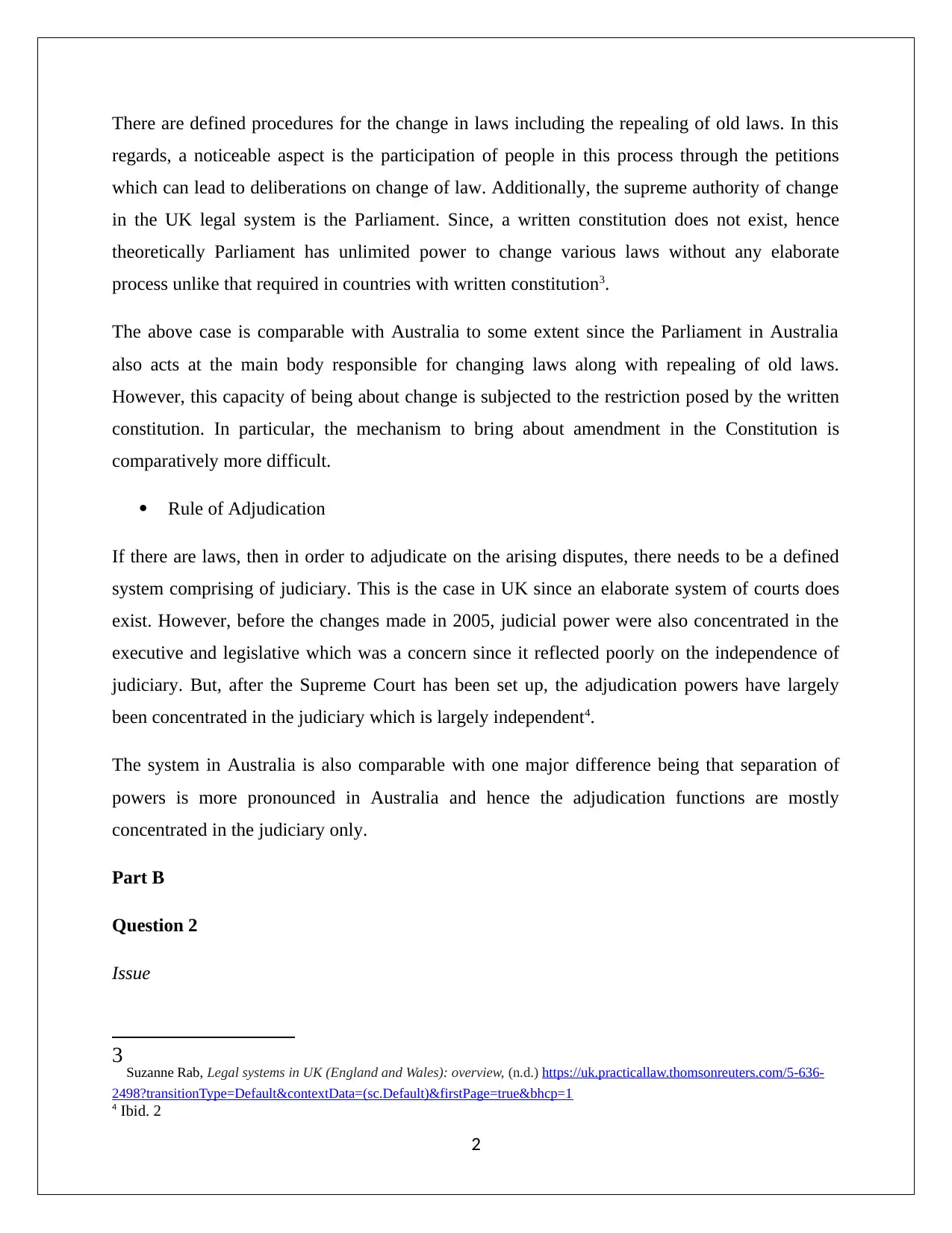
There are defined procedures for the change in laws including the repealing of old laws. In this
regards, a noticeable aspect is the participation of people in this process through the petitions
which can lead to deliberations on change of law. Additionally, the supreme authority of change
in the UK legal system is the Parliament. Since, a written constitution does not exist, hence
theoretically Parliament has unlimited power to change various laws without any elaborate
process unlike that required in countries with written constitution3.
The above case is comparable with Australia to some extent since the Parliament in Australia
also acts at the main body responsible for changing laws along with repealing of old laws.
However, this capacity of being about change is subjected to the restriction posed by the written
constitution. In particular, the mechanism to bring about amendment in the Constitution is
comparatively more difficult.
Rule of Adjudication
If there are laws, then in order to adjudicate on the arising disputes, there needs to be a defined
system comprising of judiciary. This is the case in UK since an elaborate system of courts does
exist. However, before the changes made in 2005, judicial power were also concentrated in the
executive and legislative which was a concern since it reflected poorly on the independence of
judiciary. But, after the Supreme Court has been set up, the adjudication powers have largely
been concentrated in the judiciary which is largely independent4.
The system in Australia is also comparable with one major difference being that separation of
powers is more pronounced in Australia and hence the adjudication functions are mostly
concentrated in the judiciary only.
Part B
Question 2
Issue
3 Suzanne Rab, Legal systems in UK (England and Wales): overview, (n.d.) https://uk.practicallaw.thomsonreuters.com/5-636-
2498?transitionType=Default&contextData=(sc.Default)&firstPage=true&bhcp=1
4 Ibid. 2
2
regards, a noticeable aspect is the participation of people in this process through the petitions
which can lead to deliberations on change of law. Additionally, the supreme authority of change
in the UK legal system is the Parliament. Since, a written constitution does not exist, hence
theoretically Parliament has unlimited power to change various laws without any elaborate
process unlike that required in countries with written constitution3.
The above case is comparable with Australia to some extent since the Parliament in Australia
also acts at the main body responsible for changing laws along with repealing of old laws.
However, this capacity of being about change is subjected to the restriction posed by the written
constitution. In particular, the mechanism to bring about amendment in the Constitution is
comparatively more difficult.
Rule of Adjudication
If there are laws, then in order to adjudicate on the arising disputes, there needs to be a defined
system comprising of judiciary. This is the case in UK since an elaborate system of courts does
exist. However, before the changes made in 2005, judicial power were also concentrated in the
executive and legislative which was a concern since it reflected poorly on the independence of
judiciary. But, after the Supreme Court has been set up, the adjudication powers have largely
been concentrated in the judiciary which is largely independent4.
The system in Australia is also comparable with one major difference being that separation of
powers is more pronounced in Australia and hence the adjudication functions are mostly
concentrated in the judiciary only.
Part B
Question 2
Issue
3 Suzanne Rab, Legal systems in UK (England and Wales): overview, (n.d.) https://uk.practicallaw.thomsonreuters.com/5-636-
2498?transitionType=Default&contextData=(sc.Default)&firstPage=true&bhcp=1
4 Ibid. 2
2
⊘ This is a preview!⊘
Do you want full access?
Subscribe today to unlock all pages.

Trusted by 1+ million students worldwide
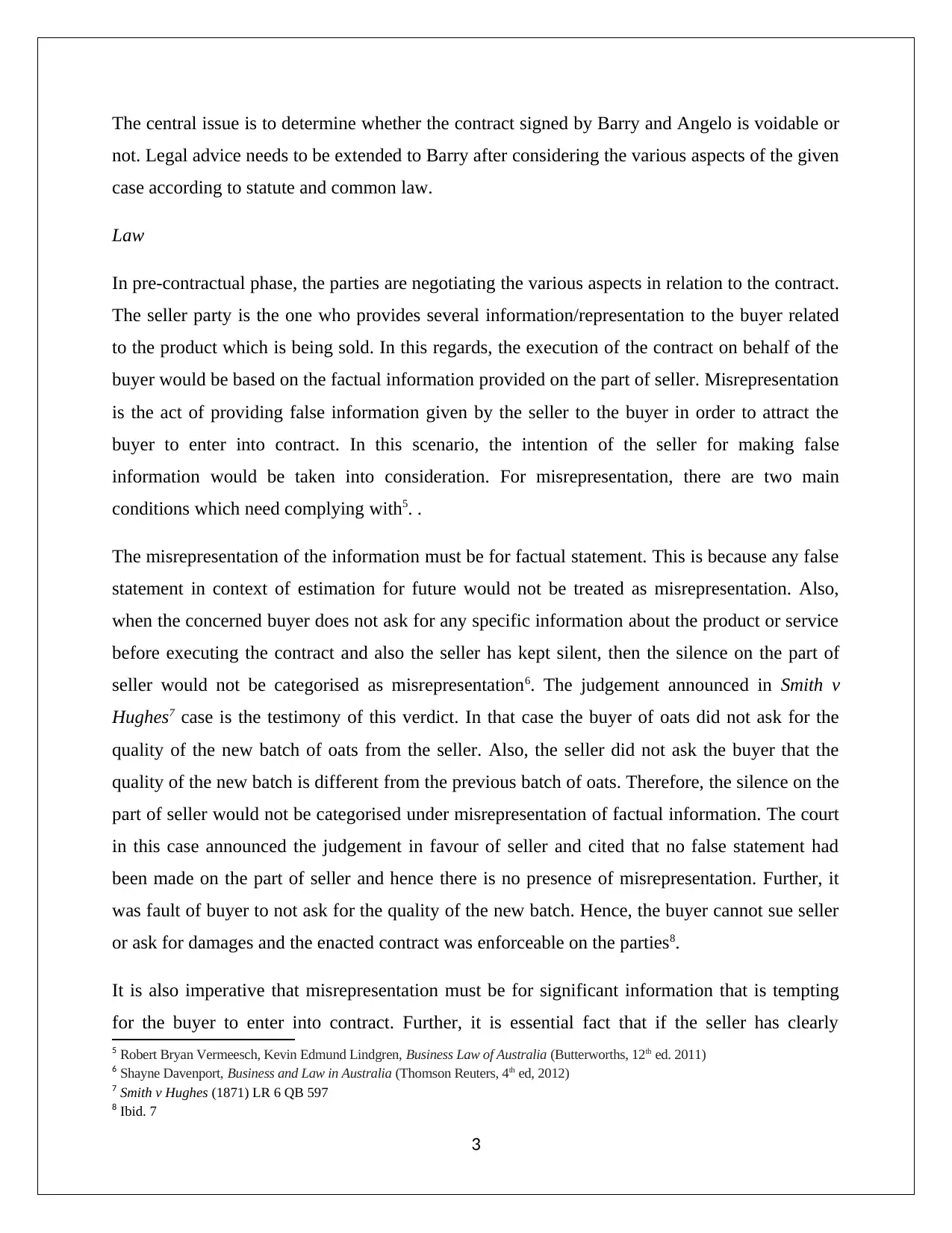
The central issue is to determine whether the contract signed by Barry and Angelo is voidable or
not. Legal advice needs to be extended to Barry after considering the various aspects of the given
case according to statute and common law.
Law
In pre-contractual phase, the parties are negotiating the various aspects in relation to the contract.
The seller party is the one who provides several information/representation to the buyer related
to the product which is being sold. In this regards, the execution of the contract on behalf of the
buyer would be based on the factual information provided on the part of seller. Misrepresentation
is the act of providing false information given by the seller to the buyer in order to attract the
buyer to enter into contract. In this scenario, the intention of the seller for making false
information would be taken into consideration. For misrepresentation, there are two main
conditions which need complying with5. .
The misrepresentation of the information must be for factual statement. This is because any false
statement in context of estimation for future would not be treated as misrepresentation. Also,
when the concerned buyer does not ask for any specific information about the product or service
before executing the contract and also the seller has kept silent, then the silence on the part of
seller would not be categorised as misrepresentation6. The judgement announced in Smith v
Hughes7 case is the testimony of this verdict. In that case the buyer of oats did not ask for the
quality of the new batch of oats from the seller. Also, the seller did not ask the buyer that the
quality of the new batch is different from the previous batch of oats. Therefore, the silence on the
part of seller would not be categorised under misrepresentation of factual information. The court
in this case announced the judgement in favour of seller and cited that no false statement had
been made on the part of seller and hence there is no presence of misrepresentation. Further, it
was fault of buyer to not ask for the quality of the new batch. Hence, the buyer cannot sue seller
or ask for damages and the enacted contract was enforceable on the parties8.
It is also imperative that misrepresentation must be for significant information that is tempting
for the buyer to enter into contract. Further, it is essential fact that if the seller has clearly
5 Robert Bryan Vermeesch, Kevin Edmund Lindgren, Business Law of Australia (Butterworths, 12th ed. 2011)
6 Shayne Davenport, Business and Law in Australia (Thomson Reuters, 4th ed, 2012)
7 Smith v Hughes (1871) LR 6 QB 597
8 Ibid. 7
3
not. Legal advice needs to be extended to Barry after considering the various aspects of the given
case according to statute and common law.
Law
In pre-contractual phase, the parties are negotiating the various aspects in relation to the contract.
The seller party is the one who provides several information/representation to the buyer related
to the product which is being sold. In this regards, the execution of the contract on behalf of the
buyer would be based on the factual information provided on the part of seller. Misrepresentation
is the act of providing false information given by the seller to the buyer in order to attract the
buyer to enter into contract. In this scenario, the intention of the seller for making false
information would be taken into consideration. For misrepresentation, there are two main
conditions which need complying with5. .
The misrepresentation of the information must be for factual statement. This is because any false
statement in context of estimation for future would not be treated as misrepresentation. Also,
when the concerned buyer does not ask for any specific information about the product or service
before executing the contract and also the seller has kept silent, then the silence on the part of
seller would not be categorised as misrepresentation6. The judgement announced in Smith v
Hughes7 case is the testimony of this verdict. In that case the buyer of oats did not ask for the
quality of the new batch of oats from the seller. Also, the seller did not ask the buyer that the
quality of the new batch is different from the previous batch of oats. Therefore, the silence on the
part of seller would not be categorised under misrepresentation of factual information. The court
in this case announced the judgement in favour of seller and cited that no false statement had
been made on the part of seller and hence there is no presence of misrepresentation. Further, it
was fault of buyer to not ask for the quality of the new batch. Hence, the buyer cannot sue seller
or ask for damages and the enacted contract was enforceable on the parties8.
It is also imperative that misrepresentation must be for significant information that is tempting
for the buyer to enter into contract. Further, it is essential fact that if the seller has clearly
5 Robert Bryan Vermeesch, Kevin Edmund Lindgren, Business Law of Australia (Butterworths, 12th ed. 2011)
6 Shayne Davenport, Business and Law in Australia (Thomson Reuters, 4th ed, 2012)
7 Smith v Hughes (1871) LR 6 QB 597
8 Ibid. 7
3
Paraphrase This Document
Need a fresh take? Get an instant paraphrase of this document with our AI Paraphraser
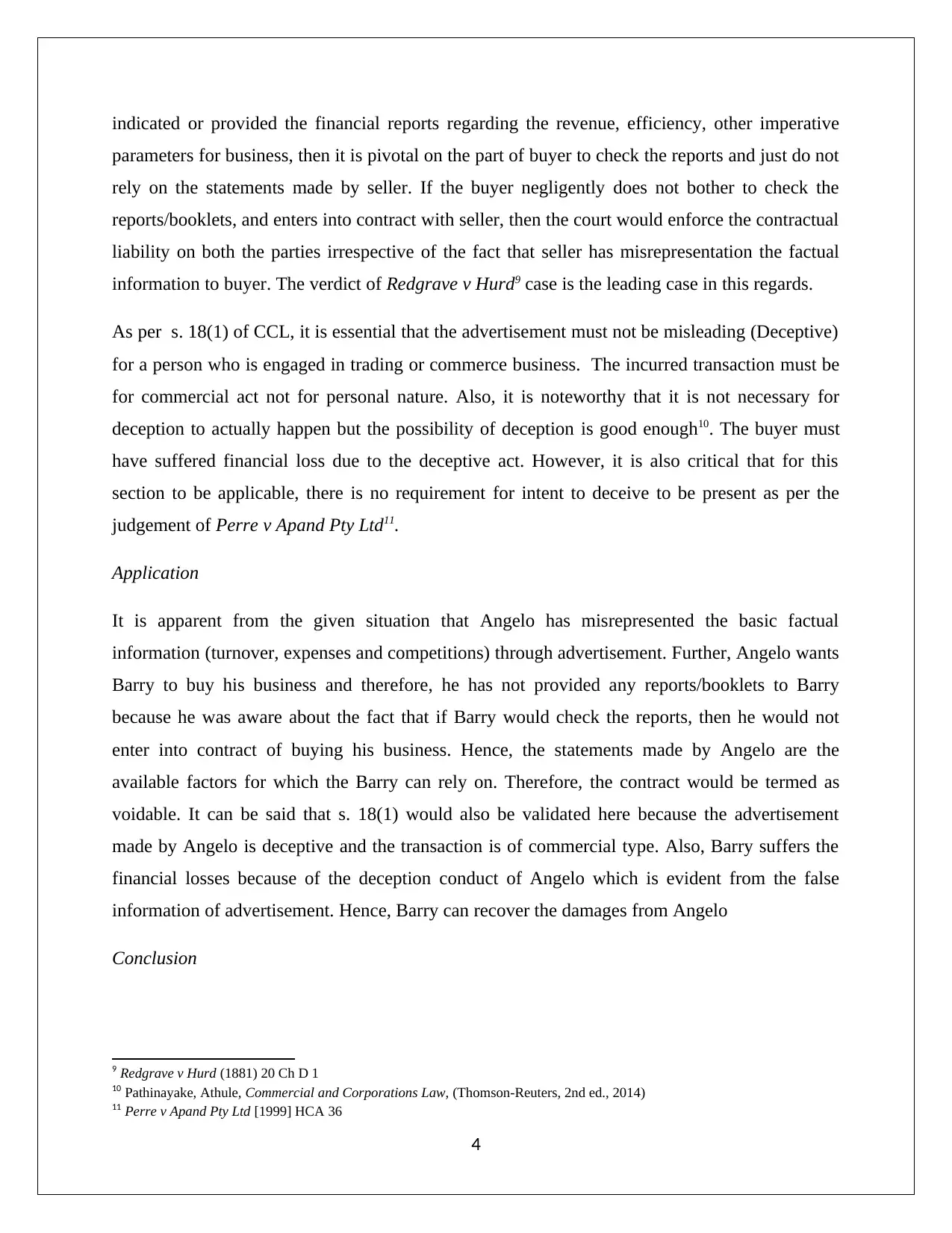
indicated or provided the financial reports regarding the revenue, efficiency, other imperative
parameters for business, then it is pivotal on the part of buyer to check the reports and just do not
rely on the statements made by seller. If the buyer negligently does not bother to check the
reports/booklets, and enters into contract with seller, then the court would enforce the contractual
liability on both the parties irrespective of the fact that seller has misrepresentation the factual
information to buyer. The verdict of Redgrave v Hurd9 case is the leading case in this regards.
As per s. 18(1) of CCL, it is essential that the advertisement must not be misleading (Deceptive)
for a person who is engaged in trading or commerce business. The incurred transaction must be
for commercial act not for personal nature. Also, it is noteworthy that it is not necessary for
deception to actually happen but the possibility of deception is good enough10. The buyer must
have suffered financial loss due to the deceptive act. However, it is also critical that for this
section to be applicable, there is no requirement for intent to deceive to be present as per the
judgement of Perre v Apand Pty Ltd11.
Application
It is apparent from the given situation that Angelo has misrepresented the basic factual
information (turnover, expenses and competitions) through advertisement. Further, Angelo wants
Barry to buy his business and therefore, he has not provided any reports/booklets to Barry
because he was aware about the fact that if Barry would check the reports, then he would not
enter into contract of buying his business. Hence, the statements made by Angelo are the
available factors for which the Barry can rely on. Therefore, the contract would be termed as
voidable. It can be said that s. 18(1) would also be validated here because the advertisement
made by Angelo is deceptive and the transaction is of commercial type. Also, Barry suffers the
financial losses because of the deception conduct of Angelo which is evident from the false
information of advertisement. Hence, Barry can recover the damages from Angelo
Conclusion
9 Redgrave v Hurd (1881) 20 Ch D 1
10 Pathinayake, Athule, Commercial and Corporations Law, (Thomson-Reuters, 2nd ed., 2014)
11 Perre v Apand Pty Ltd [1999] HCA 36
4
parameters for business, then it is pivotal on the part of buyer to check the reports and just do not
rely on the statements made by seller. If the buyer negligently does not bother to check the
reports/booklets, and enters into contract with seller, then the court would enforce the contractual
liability on both the parties irrespective of the fact that seller has misrepresentation the factual
information to buyer. The verdict of Redgrave v Hurd9 case is the leading case in this regards.
As per s. 18(1) of CCL, it is essential that the advertisement must not be misleading (Deceptive)
for a person who is engaged in trading or commerce business. The incurred transaction must be
for commercial act not for personal nature. Also, it is noteworthy that it is not necessary for
deception to actually happen but the possibility of deception is good enough10. The buyer must
have suffered financial loss due to the deceptive act. However, it is also critical that for this
section to be applicable, there is no requirement for intent to deceive to be present as per the
judgement of Perre v Apand Pty Ltd11.
Application
It is apparent from the given situation that Angelo has misrepresented the basic factual
information (turnover, expenses and competitions) through advertisement. Further, Angelo wants
Barry to buy his business and therefore, he has not provided any reports/booklets to Barry
because he was aware about the fact that if Barry would check the reports, then he would not
enter into contract of buying his business. Hence, the statements made by Angelo are the
available factors for which the Barry can rely on. Therefore, the contract would be termed as
voidable. It can be said that s. 18(1) would also be validated here because the advertisement
made by Angelo is deceptive and the transaction is of commercial type. Also, Barry suffers the
financial losses because of the deception conduct of Angelo which is evident from the false
information of advertisement. Hence, Barry can recover the damages from Angelo
Conclusion
9 Redgrave v Hurd (1881) 20 Ch D 1
10 Pathinayake, Athule, Commercial and Corporations Law, (Thomson-Reuters, 2nd ed., 2014)
11 Perre v Apand Pty Ltd [1999] HCA 36
4
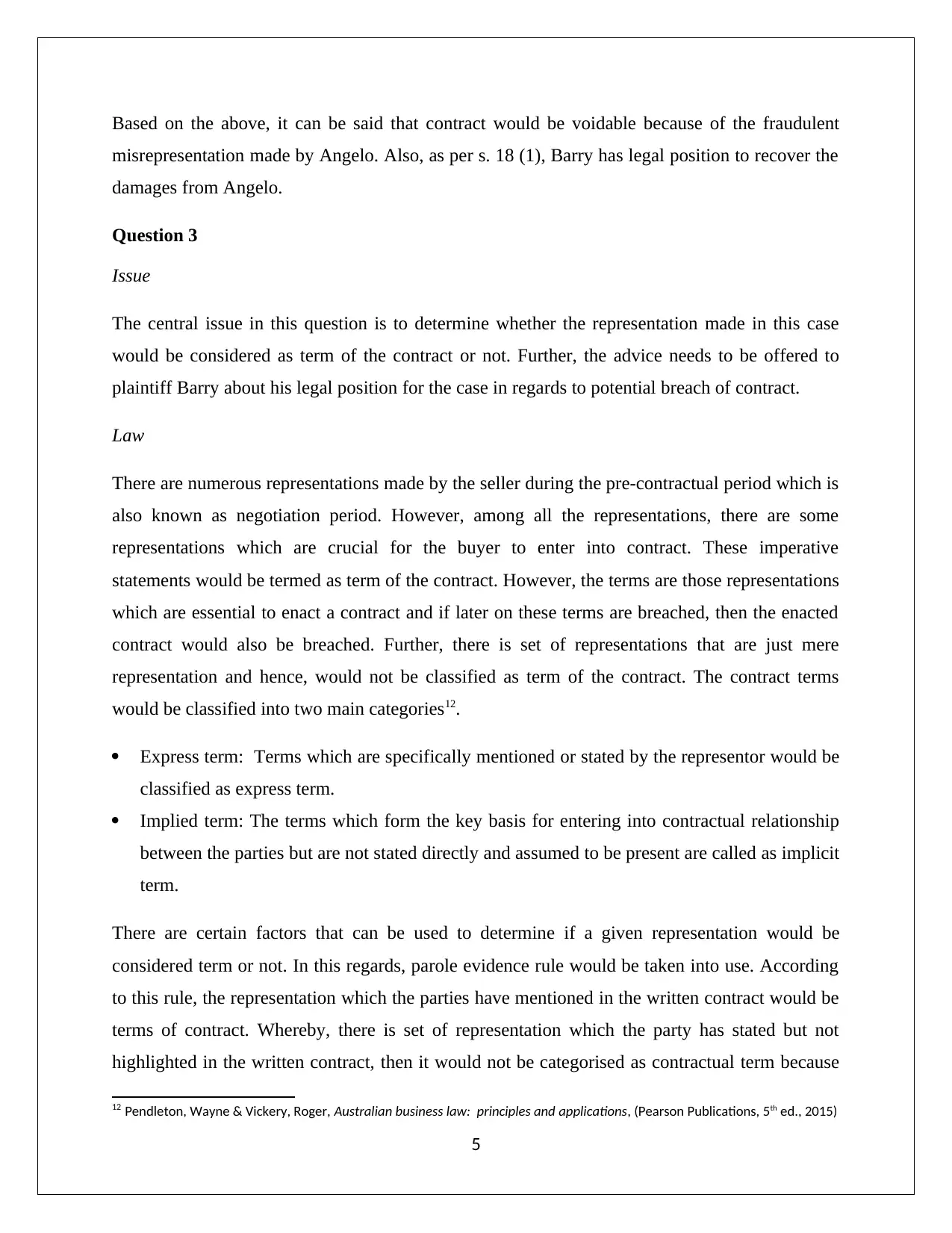
Based on the above, it can be said that contract would be voidable because of the fraudulent
misrepresentation made by Angelo. Also, as per s. 18 (1), Barry has legal position to recover the
damages from Angelo.
Question 3
Issue
The central issue in this question is to determine whether the representation made in this case
would be considered as term of the contract or not. Further, the advice needs to be offered to
plaintiff Barry about his legal position for the case in regards to potential breach of contract.
Law
There are numerous representations made by the seller during the pre-contractual period which is
also known as negotiation period. However, among all the representations, there are some
representations which are crucial for the buyer to enter into contract. These imperative
statements would be termed as term of the contract. However, the terms are those representations
which are essential to enact a contract and if later on these terms are breached, then the enacted
contract would also be breached. Further, there is set of representations that are just mere
representation and hence, would not be classified as term of the contract. The contract terms
would be classified into two main categories12.
Express term: Terms which are specifically mentioned or stated by the representor would be
classified as express term.
Implied term: The terms which form the key basis for entering into contractual relationship
between the parties but are not stated directly and assumed to be present are called as implicit
term.
There are certain factors that can be used to determine if a given representation would be
considered term or not. In this regards, parole evidence rule would be taken into use. According
to this rule, the representation which the parties have mentioned in the written contract would be
terms of contract. Whereby, there is set of representation which the party has stated but not
highlighted in the written contract, then it would not be categorised as contractual term because
12 Pendleton, Wayne & Vickery, Roger, Australian business law: principles and applications, (Pearson Publications, 5th ed., 2015)
5
misrepresentation made by Angelo. Also, as per s. 18 (1), Barry has legal position to recover the
damages from Angelo.
Question 3
Issue
The central issue in this question is to determine whether the representation made in this case
would be considered as term of the contract or not. Further, the advice needs to be offered to
plaintiff Barry about his legal position for the case in regards to potential breach of contract.
Law
There are numerous representations made by the seller during the pre-contractual period which is
also known as negotiation period. However, among all the representations, there are some
representations which are crucial for the buyer to enter into contract. These imperative
statements would be termed as term of the contract. However, the terms are those representations
which are essential to enact a contract and if later on these terms are breached, then the enacted
contract would also be breached. Further, there is set of representations that are just mere
representation and hence, would not be classified as term of the contract. The contract terms
would be classified into two main categories12.
Express term: Terms which are specifically mentioned or stated by the representor would be
classified as express term.
Implied term: The terms which form the key basis for entering into contractual relationship
between the parties but are not stated directly and assumed to be present are called as implicit
term.
There are certain factors that can be used to determine if a given representation would be
considered term or not. In this regards, parole evidence rule would be taken into use. According
to this rule, the representation which the parties have mentioned in the written contract would be
terms of contract. Whereby, there is set of representation which the party has stated but not
highlighted in the written contract, then it would not be categorised as contractual term because
12 Pendleton, Wayne & Vickery, Roger, Australian business law: principles and applications, (Pearson Publications, 5th ed., 2015)
5
⊘ This is a preview!⊘
Do you want full access?
Subscribe today to unlock all pages.

Trusted by 1+ million students worldwide
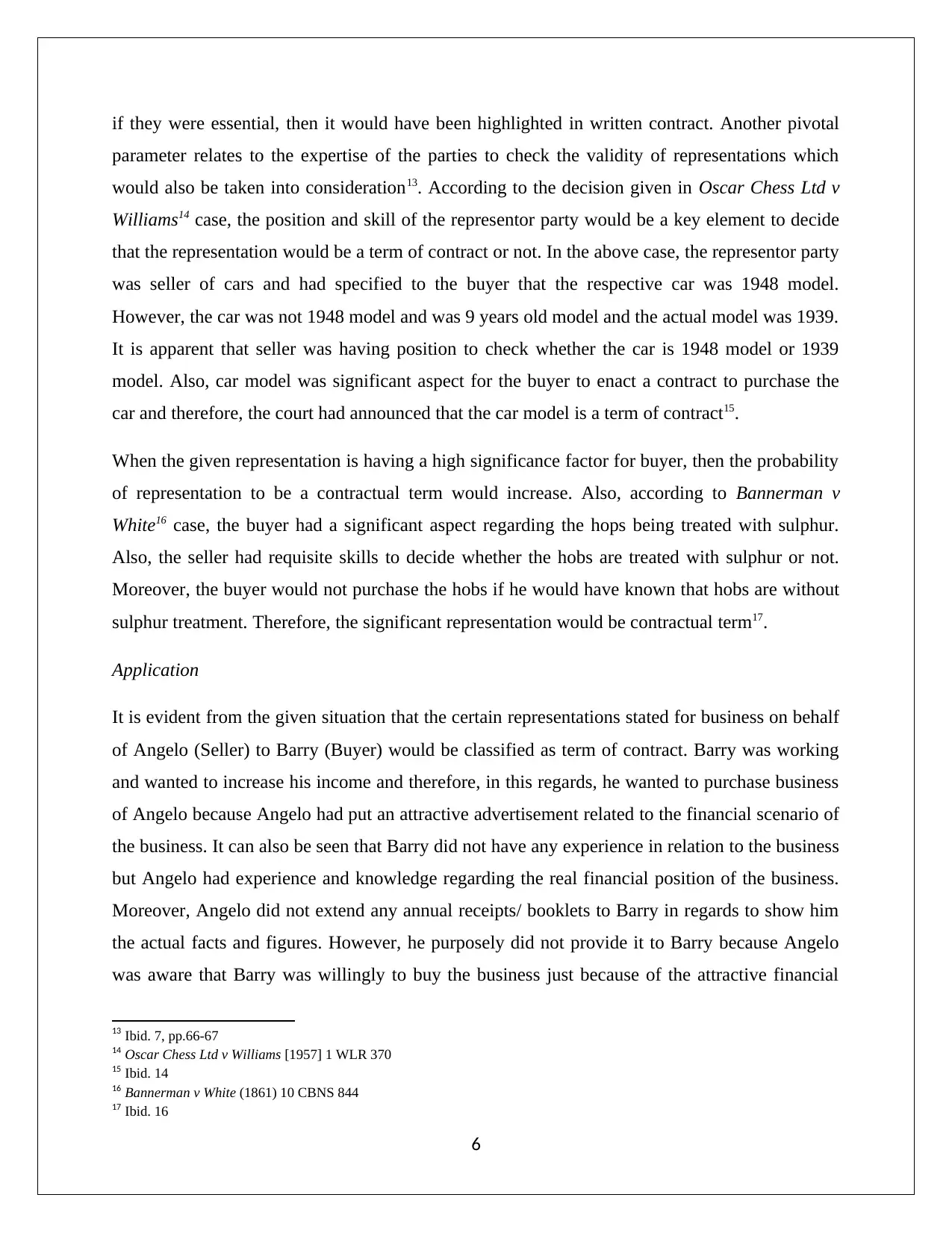
if they were essential, then it would have been highlighted in written contract. Another pivotal
parameter relates to the expertise of the parties to check the validity of representations which
would also be taken into consideration13. According to the decision given in Oscar Chess Ltd v
Williams14 case, the position and skill of the representor party would be a key element to decide
that the representation would be a term of contract or not. In the above case, the representor party
was seller of cars and had specified to the buyer that the respective car was 1948 model.
However, the car was not 1948 model and was 9 years old model and the actual model was 1939.
It is apparent that seller was having position to check whether the car is 1948 model or 1939
model. Also, car model was significant aspect for the buyer to enact a contract to purchase the
car and therefore, the court had announced that the car model is a term of contract15.
When the given representation is having a high significance factor for buyer, then the probability
of representation to be a contractual term would increase. Also, according to Bannerman v
White16 case, the buyer had a significant aspect regarding the hops being treated with sulphur.
Also, the seller had requisite skills to decide whether the hobs are treated with sulphur or not.
Moreover, the buyer would not purchase the hobs if he would have known that hobs are without
sulphur treatment. Therefore, the significant representation would be contractual term17.
Application
It is evident from the given situation that the certain representations stated for business on behalf
of Angelo (Seller) to Barry (Buyer) would be classified as term of contract. Barry was working
and wanted to increase his income and therefore, in this regards, he wanted to purchase business
of Angelo because Angelo had put an attractive advertisement related to the financial scenario of
the business. It can also be seen that Barry did not have any experience in relation to the business
but Angelo had experience and knowledge regarding the real financial position of the business.
Moreover, Angelo did not extend any annual receipts/ booklets to Barry in regards to show him
the actual facts and figures. However, he purposely did not provide it to Barry because Angelo
was aware that Barry was willingly to buy the business just because of the attractive financial
13 Ibid. 7, pp.66-67
14 Oscar Chess Ltd v Williams [1957] 1 WLR 370
15 Ibid. 14
16 Bannerman v White (1861) 10 CBNS 844
17 Ibid. 16
6
parameter relates to the expertise of the parties to check the validity of representations which
would also be taken into consideration13. According to the decision given in Oscar Chess Ltd v
Williams14 case, the position and skill of the representor party would be a key element to decide
that the representation would be a term of contract or not. In the above case, the representor party
was seller of cars and had specified to the buyer that the respective car was 1948 model.
However, the car was not 1948 model and was 9 years old model and the actual model was 1939.
It is apparent that seller was having position to check whether the car is 1948 model or 1939
model. Also, car model was significant aspect for the buyer to enact a contract to purchase the
car and therefore, the court had announced that the car model is a term of contract15.
When the given representation is having a high significance factor for buyer, then the probability
of representation to be a contractual term would increase. Also, according to Bannerman v
White16 case, the buyer had a significant aspect regarding the hops being treated with sulphur.
Also, the seller had requisite skills to decide whether the hobs are treated with sulphur or not.
Moreover, the buyer would not purchase the hobs if he would have known that hobs are without
sulphur treatment. Therefore, the significant representation would be contractual term17.
Application
It is evident from the given situation that the certain representations stated for business on behalf
of Angelo (Seller) to Barry (Buyer) would be classified as term of contract. Barry was working
and wanted to increase his income and therefore, in this regards, he wanted to purchase business
of Angelo because Angelo had put an attractive advertisement related to the financial scenario of
the business. It can also be seen that Barry did not have any experience in relation to the business
but Angelo had experience and knowledge regarding the real financial position of the business.
Moreover, Angelo did not extend any annual receipts/ booklets to Barry in regards to show him
the actual facts and figures. However, he purposely did not provide it to Barry because Angelo
was aware that Barry was willingly to buy the business just because of the attractive financial
13 Ibid. 7, pp.66-67
14 Oscar Chess Ltd v Williams [1957] 1 WLR 370
15 Ibid. 14
16 Bannerman v White (1861) 10 CBNS 844
17 Ibid. 16
6
Paraphrase This Document
Need a fresh take? Get an instant paraphrase of this document with our AI Paraphraser
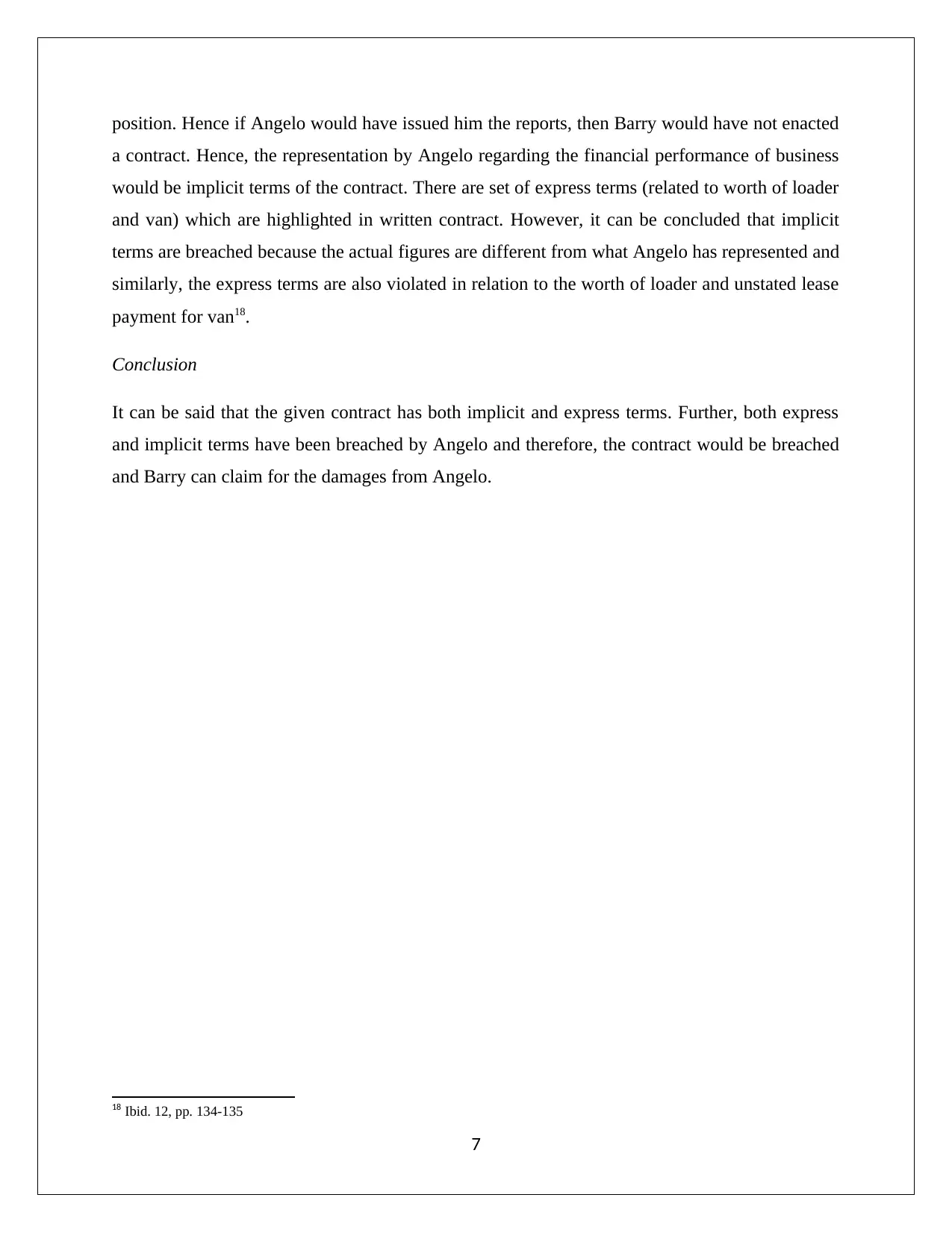
position. Hence if Angelo would have issued him the reports, then Barry would have not enacted
a contract. Hence, the representation by Angelo regarding the financial performance of business
would be implicit terms of the contract. There are set of express terms (related to worth of loader
and van) which are highlighted in written contract. However, it can be concluded that implicit
terms are breached because the actual figures are different from what Angelo has represented and
similarly, the express terms are also violated in relation to the worth of loader and unstated lease
payment for van18.
Conclusion
It can be said that the given contract has both implicit and express terms. Further, both express
and implicit terms have been breached by Angelo and therefore, the contract would be breached
and Barry can claim for the damages from Angelo.
18 Ibid. 12, pp. 134-135
7
a contract. Hence, the representation by Angelo regarding the financial performance of business
would be implicit terms of the contract. There are set of express terms (related to worth of loader
and van) which are highlighted in written contract. However, it can be concluded that implicit
terms are breached because the actual figures are different from what Angelo has represented and
similarly, the express terms are also violated in relation to the worth of loader and unstated lease
payment for van18.
Conclusion
It can be said that the given contract has both implicit and express terms. Further, both express
and implicit terms have been breached by Angelo and therefore, the contract would be breached
and Barry can claim for the damages from Angelo.
18 Ibid. 12, pp. 134-135
7
1 out of 8
Related Documents
Your All-in-One AI-Powered Toolkit for Academic Success.
+13062052269
info@desklib.com
Available 24*7 on WhatsApp / Email
![[object Object]](/_next/static/media/star-bottom.7253800d.svg)
Unlock your academic potential
Copyright © 2020–2025 A2Z Services. All Rights Reserved. Developed and managed by ZUCOL.





